This was published 9 years ago
India wildlife adventure: Watching tigers in the jungle
Spotting a Bengal tiger is the big prize but there are other creatures to enjoy, writes Julie Miller.
By Julie Miller
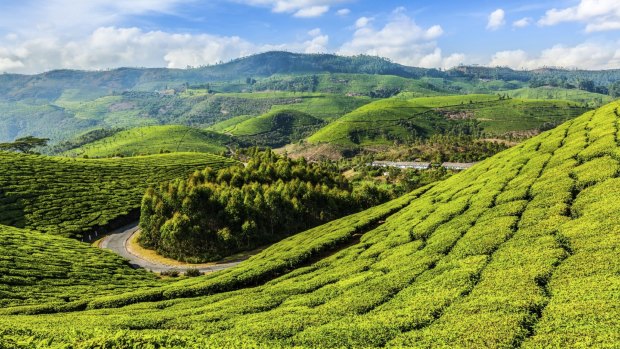
Welcome to the jungle: Green tea plantations in Munnar, Kerala, India.Credit: iStock
I've just encountered the most terrifying creature in the Indian forest. It rears before me, ready to attack, riled by the scent of my blood. I back off slowly, hoping if I give it space it will capitulate. But I soon realise that my assailant is not alone – and there is no escape.
Fortunately, help is at hand, in the form of a brown tobacco powder. On contact, the dozen or so leeches crawling over my purple sparkly Converse recoil back into the mud, quelled until a less-prepared victim passes by.
Phew, crisis averted. It's a jungle out there.
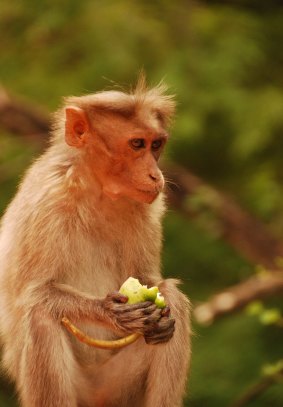
A macaque at Chinnar National Park.Credit: Julie Miller
Here, in the dark, misty wilds of Periyar Tiger Reserve in Kerala, southern India, every animal, from the smallest insect to the largest predator, is part of the food chain – including the most invasive presence, man. And while I long to see the jewel in this park's ecosystem – the Bengal tiger – I'm quietly relieved that so far, we haven't had to make a dash for our lives.
We are on an early-morning walking safari through the reserve – yes, on foot, not in a jeep: hence my reticence. But I've been told we'd be extremely lucky – or perhaps unlucky – to spot a tiger in this large, dense terrain, with the big cats extremely elusive, well camouflaged, and of course, extremely rare.
According to the latest census conducted in 2014, India's tiger population has risen by nearly 30 per cent in three years from 1706 to 2226 - great news indeed and a triumph for wildlife conservation. The state of Kerala's tiger population alone has increased from 71 to an incredible 136, based on data sourced from the latest technology, including camera traps, digital imaging of pug marks, tagging and satellite data.
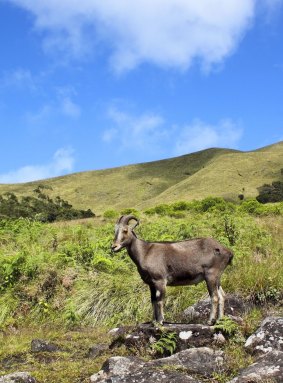
Rare Nilgiri tahr goat.Credit: 123.com
The tiger's wide territorial range, however, does make it difficult to pinpoint exact numbers, and our guide on this safari - a tribesman named Thankappan who has lived in this forest all his life and now works for the Parks Service - believes there could be as many as 55 tigers roaming Periyar Tiger Reserve, a 925 square kilometre wilderness.
Clearly, however, he's not concerned about a close encounter; he doesn't carry a gun, and his only weapon against rampaging wildlife is tobacco powder to deter ferocious leeches. He does, however, have excellent hearing, and reads this jungle like a book, spotting flitting birds, shy deer and canopy-dwelling monkeys without the use of binoculars.
Periyar Tiger Reserve is one of 47 designated areas governed by Project Tiger in an attempt to protect India's vulnerable population of tigers. At the heart of this mountainous terrain in the Cardamom Hills is a lake, created in 1895 when the Periyar River was dammed. The land has been a protected zone since 1899; it became a tiger reserve in 1978. While the preservation of the tiger population is paramount, the reserve also boasts a huge biodiversity of animals, with 66 species of mammals including Asian elephants, sloth bears, guar, sambar and leopard, and more than 300 species of birds.
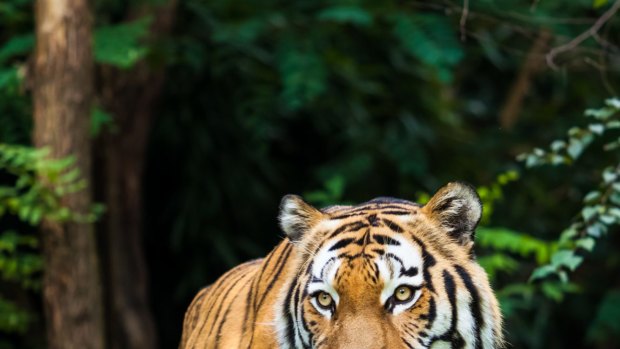
The holy grail: A Bengal tiger.Credit: 123.com
The most popular way of viewing wildlife is on a boat trip along the lake; but with at least 100 shouting, jostling tourists clambering for photo opportunities and no interpretative information, this proves to be a fairly frustrating exercise.
"Did you see anything?" I overhear one tour guide ask his group on their return. "Nothing," they collectively sigh. In other words, they didn't see a tiger, a leopard or elephants. Despite the fact that our cruise had, indeed, glided past herds of grazing sambar, wild pigs playing in the mud and egrets nesting on submerged trees. To these visitors, only the "big" animals – the popular kids in the playground – seem to matter.
Our morning hike, fortunately, proves a stark contrast to the cruise debacle. Apart from a group of Munnan tribespeople – who retain hunting and gathering rights in the forest – we are the only humans venturing through this section of forest; and instead of incessant chatter and yelling, we are treated to the sounds of the jungle as the rising sun pierces the canopy – the buzz of cicadas, the caw of birds and the shiver of leaves as a giant squirrel leaps from branch to branch.
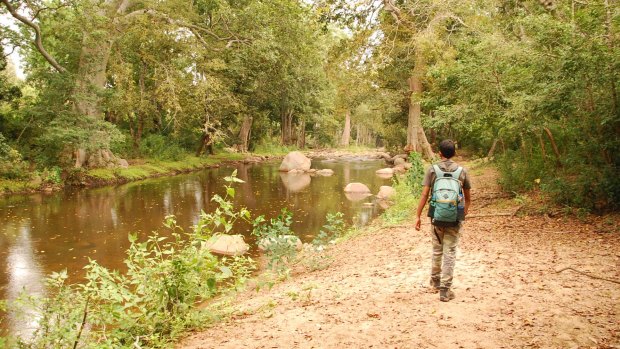
Trekking at Chinnar National Park. Credit: Julie Miller
As well as having a sharp eye for watchful barking deer and being able to identify the distant whoop of a mating black monkey, our guide Thankappan delights in the small creatures, pointing out spindle-legged spiders in gossamer webs, iridescent dragonflies and resplendent birds, including rocket-tailed drongos, orange-chested rufus treepie, and lesser hornbills. By the end of our two-and-a-half-hour walk, we have become veritable twitchers, as excited by the feathered inhabitants of this pristine wilderness as the furry variety.
Two days later, we visit another Keralan national park, Eravikulam. The closest wildlife reserve to the hill station of Munnar, it provides sanctuary for a creature almost as rare as the tiger but certainly not as infamous – the nilgiri tahr. A type of mountain goat, there are fewer than 2000 left in the wild, with Eravikulam boasting almost half of them.
It's raining as we set off from the national park ticket office on a shuttle bus, which winds its way up a perilous road to the small section of park open to the public. En route, we spot a herd of elephants trudging through a tea plantation, camouflaged amongst tall trees between sculpted emerald terraces. It's certainly a good start to the day, and we're feeling optimistic as we approach the ethereal, rocky slopes that the tahr is said to inhabit.
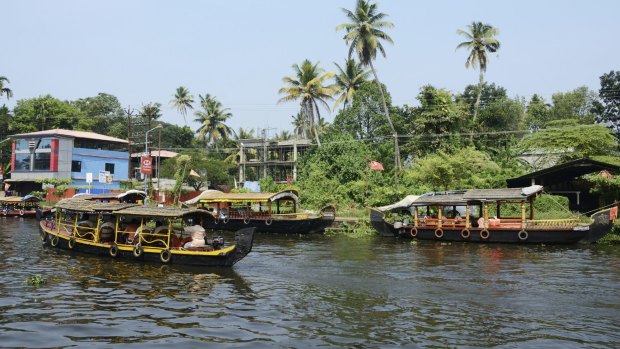
Tourist boats at Kerala backwaters in Alleppey.Credit: iStock
As it turns out, the nilgiri Tahr is as brazen as the tiger is shy, with several herds bounding over the slippery rocks without a care in the world. A proud buck eyeballs us fearlessly from his elevated throne, an ungulate Brad Pitt with his coarse grey coat, amber eyes and arched horns; while a couple of youngsters wander down the bitumen pathway, posing for photo opportunities and head-butting us to shift out of their way.
As awesome as it is to be this close to an endangered species, the nilgiri tahr's bold behaviour has historically been its downfall, hunted and poached to near-extinction. Strict monitoring within the park now ensures the remaining herd's survival, with the tourist zone closed during kidding season and private vehicles prevented from entering park boundaries.
Just north of Munnar, bordering the state of Tamil Nadu, is a very different wildlife preserve called Chinnar Wildlife Sanctuary. Falling in the rainshadow of the Western Ghats, its terrain is as scrubby, thorny and stark as Periyar and Eravikulam are lush. This park is home to elephants, gaur, sambar, macaques, endangered grizzled giant squirrels and a small population of tigers; it also has the most reptilian fauna in Kerala, including the mugger crocodile.
Average rainfall in Chinnar is just 500 millimetres a year – all of it seemingly bucketing down on us during our afternoon walking safari. Within minutes, we are soaked to the bone, the monsoonal downpour relentless for more than an hour as we shelter, miserable, beneath the spreading branches of an Indian almond tree. Rather than continue our trek in such inclement conditions, we decide to cut it short, returning to base via a watchtower with views across the river to Tamil Nadu.
As quickly as the storm commenced, however, so it clears; and as we climb to the viewing platform of the metal tower, we are rewarded with expansive views of the scrubland rejuvenated by the life-giving waters. In the distance we spy a herd of sambar, on high alert and seemingly looking our way; while some spotted deer dart from beneath bushes, skittish in the oozing mud.
Still dripping, we allow the warm breeze to dry our soaked clothing as we gaze into the far blue yonder, absorbing every flutter of a leaf, or stirring of grasses. From being cranky, wet and defeated, we are suddenly as invigorated as the landscape around us, our "failed" safari turned on its head into a beautiful, unexpected and positive experience.
Five other Indian sanctuaries
1. Corbett National Park, Uttarakhand: The oldest national park in mainland Asia, this dense forest boasts a large population of aboutaround 200 tigers as well as leopards, elephants and langur.
2. Ranthambore, Rajastahan: This is arguably the most reliable place to spot tigers, with good visibility in the dry, scrubby terrain. Other creatures include sloth bear, jackal and leopard.
3. Kaziranga NP, Assam: An important stronghold for endangered Indian one-horned rhinoceros as well as home to manylarge numbers of elephants, water buffalo and tigers.
4. Sunderbans, West Bengal: This UNESCO World Heritage site bordering Bangladesh is a massive wetland where tigers have adapted to life in the saltwater mangroves. Tours of the wetland are by boat only.
5. Gir, Gujrat: This is the last bastion of the endangered Asiatic lion, of which there are only 411 left. It is also a popular bird-watching destination with more thanover 300 species of avifauna.
TRIP NOTES
MORE INFORMATION
GETTING THERE
Air India flies daily from Sydney via Melbourne to Delhi, with domestic transfers to Kochi.
STAYING THERE
Spice Village offers 4-star cottage accommodation near Periyar Tiger Reserve, see cghearth.com. Mantra Wild Adventures' 11 day package to Kerala includes accommodation, activities and safaris in Periyar, Eravikulam and Chinnar National Parks from $3199 per person twin share. See mantrawild.com.au
The writer travelled as a guest of Mantra Wild Adventures.
Sign up for the Traveller Deals newsletter
Get exclusive travel deals delivered straight to your inbox. Sign up now.